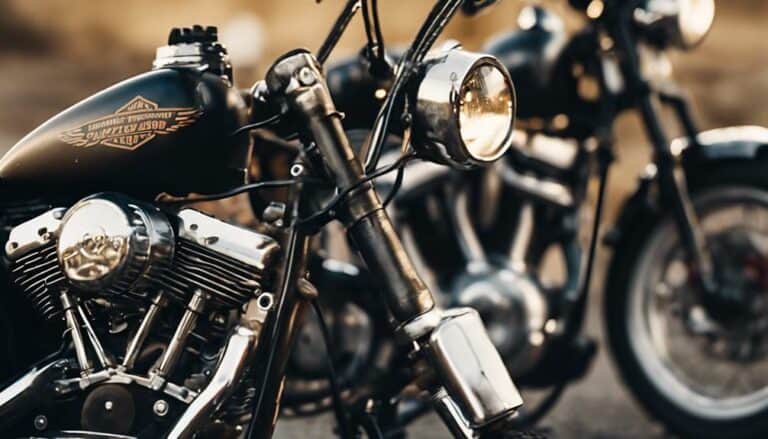Have you ever wondered when exactly the Harley Davidson Sportster made the monumental shift to fuel injection technology?
The transition to fuel injection brought about a significant transformation in the Sportster line, revolutionizing its performance capabilities.
This change not only modernized the bikes but also enhanced the overall riding experience for Harley enthusiasts.
The move to fuel injection marked a turning point for the Sportster models, paving the way for improved efficiency and a new era of motorcycle engineering.
Key Takeaways
- The transition to fuel injection in Harley Sportster models occurred in 2007.
- Fuel injection technology revolutionized Sportster performance and efficiency.
- Riders benefited from instant starts, smoother idling, and improved throttle response.
- Fuel injection is now the standard, offering enhanced acceleration and reduced maintenance for Sportster riders.
Evolution of Harley-Davidson Sportster Models
The evolution of Harley-Davidson Sportster models saw a significant shift in 2007 when fuel injection became standard across the lineup, marking a pivotal moment in the model's history. This change revolutionized the Sportster engine, enhancing its performance, efficiency, and overall riding experience.
The transition to fuel injection in the Sportster lineup meant that riders could enjoy improved throttle response, smoother operation, and better fuel economy compared to carbureted models. The inclusion of fuel injection technology in the Sportster engines also brought about easier starting, especially in varying weather conditions, and reduced maintenance requirements, providing riders with a more reliable and hassle-free experience on the road.
With EFI becoming the norm in Harley-Davidson models, including the Sportster, riders could now benefit from the advancements in engine technology that not only enhanced performance but also contributed to a more environmentally friendly ride.
Transition to Fuel Injection Technology
In 2007, Harley Davidson Sportster models made a significant leap forward by transitioning to fuel injection technology. Before this, EFI was an option on all Harley models except Sportsters. However, after 2007, carbureted models were gradually phased out, making EFI the standard on all Harley models. This change marked a pivotal moment in the evolution of Harley Davidson motorcycles, as fuel injection offered improved fuel efficiency, throttle response, and overall engine performance compared to carbureted systems.
Interestingly, Harley's first foray into EFI technology was seen on the 30th-anniversary Electra Glide Ultra Classic in 1995, followed by its availability on all touring models in 1996. The adoption of fuel injection in Sportster models not only aligned them with the technological advancements present in other Harley Davidson bikes but also enhanced the riding experience for enthusiasts seeking modern features and improved engine performance. This shift to fuel injection technology in the Sportster lineup exemplifies Harley Davidson's commitment to innovation and meeting the evolving demands of riders.
Impact of Fuel Injection on Performance
With the introduction of fuel injection in 2007, Harley Davidson Sportster models experienced a significant enhancement in performance capabilities, offering riders instant starts and smoother idling. The switch from carburetors to fuel injection systems eliminated the need for choke adjustments and waiting for warm-up before hitting the road. This change not only made starting the bike more convenient but also improved overall performance.
EFI models in Sportsters delivered better acceleration and smoother power delivery compared to their carbureted counterparts. The integration of fuel injection technology in belt-driven Sportsters further enhanced the riding experience by minimizing driveline lash and ensuring smooth acceleration.
This transition marked a pivotal moment in the evolution of Harley Davidson Sportster motorcycles, as it brought about a notable improvement in both convenience and performance, catering to the needs of riders who seek liberation on the open road.
Benefits of Fuel Injection for Riders
Enhancing the riding experience significantly, fuel injection in Harley-Davidson Sportster models revolutionized performance capabilities starting from 2007. Riders have embraced this change due to the numerous benefits it brings. Here are four key advantages of fuel injection for riders:
- Instant Starts: With fuel injection, gone are the days of struggling with choke adjustments. The bike starts instantly, allowing you to hit the road without delays.
- Smooth Idling: Fuel-injected Sportsters provide a stable and consistent idle, enhancing the overall riding experience by eliminating rough idling common with carbureted models.
- Acceleration: Riders enjoy seamless acceleration thanks to fuel injection technology. The throttle response is quick and precise, offering a thrilling ride every time you twist the throttle.
- Convenience: Fuel injection eliminates the need to wait for warm-up periods before riding, allowing you to hop on your Sportster and go. This convenience factor adds to the overall appeal of fuel-injected models for riders seeking a hassle-free experience.
Future of Fuel Injection in Sportsters
The evolution of fuel injection technology in Harley-Davidson Sportster models continues to shape the future of performance and efficiency for riders. Since the introduction of fuel injection in Sportsters in 2007, there's been a significant shift towards EFI, leading to a decrease in the prevalence of carbureted models.
This transition to EFI not only improved the overall performance of Sportsters but also aligned them with the industry trend towards electronic fuel injection systems. Post-2007, EFI became a standard feature on all Harley models, solidifying its place as the preferred fuel delivery method.
Delphi's EFI system played a crucial role in this transition, offering a reliable and efficient fuel injection solution that catered to the diverse needs of Harley riders. As technology advances and environmental regulations become more stringent, the future of fuel injection in Sportsters looks promising, promising enhanced performance, better fuel efficiency, and a more responsive riding experience for enthusiasts seeking liberation on the road.
Conclusion
In conclusion, the Harley Davidson Sportster embraced fuel injection technology in 2007, ushering in a new era of performance and efficiency.
This transition marked a significant improvement in start-up reliability, idle smoothness, and acceleration, ultimately enhancing the overall riding experience.
The shift towards fuel injection in Sportster models represents a pivotal step towards modernization and convenience for riders, ensuring a seamless and hassle-free journey on the road.

